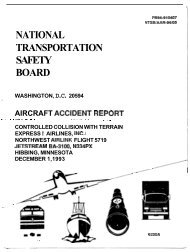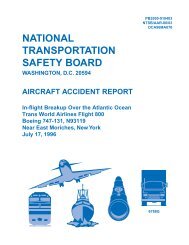NTSB/AAR-84-09 - AirDisaster.Com
NTSB/AAR-84-09 - AirDisaster.Com
NTSB/AAR-84-09 - AirDisaster.Com
Create successful ePaper yourself
Turn your PDF publications into a flip-book with our unique Google optimized e-Paper software.
The cockpit door was left open throughout the descent. The ceptak testified<br />
that he did not remember the door's being open and that he did not order it opened.<br />
During the initial stages of the descent, the cabin crew completed moving tbe<br />
passengers forward of row 13. They briefed them on the emergency evacuation<br />
procedures and passed out wet napkins until instructed by the first officer to sit down.<br />
They also designated passengers to open the overwing exits and briefed them on opening<br />
them; they then prepared them for the landing.<br />
After the initial level off at 3,003 feet, the captain ordered the first officer to<br />
depressurize the airplane in preparation for landing. The first officer complied, and<br />
although it is not required by the emergency procedure checklist, he turned the air<br />
conditioning end pressurization packs off. He testified that although he knew this was not<br />
required by procedure, he did so "because the smoke was getting bad at that point ana my<br />
reasoning was I have to do something. . . .'I He said that he thought the packs were<br />
feeding the fire. A few moments afterwaid, he opened his sliding window in an effort to<br />
clear the smoke Prom the cockpit, but closed it almost immediately because of the high<br />
noise level. The first officer opened and closed the window several times during the final<br />
stage of the flight.<br />
%-hen the captain sighted the runway, he extended the landing gear. Since the<br />
hOFiZGR?al stabilizer was inoperative, the captairi extended the flaps and slats<br />
incrementally thrcugt! the Oo, j0, Iso, 2.53 End 40" positions. He allowed his indicated<br />
airspeed to stabilize at each flap position as he slowed to approach speed. He flew the<br />
final approach at 143 KIAS md completed ?he landirg. After touchdown, he made a<br />
maximum effort stop (using extended spoilers and full brakes). Because of the loss of the<br />
left and rlgh? a.c. buses, the antiskid system iues inoperative and the fow main wheel<br />
tiires blew out. The airplane was stopped just short of the intersection of taxiivay J. (See<br />
figure 1.) Ailer thc captain completed the emergency engine shutdown checklist, 5o?h he<br />
and the first officer attexpted to go back into the cabin an$ assist in the passenger<br />
evec~ation~ but were driven back by the smoke and heat. Thereafter, they exited the<br />
airplaze through their respective cockpit sliding windows.<br />
After :he airphx stopped, the left (5-1) and right !X-?) forward cabin doors,<br />
the left forward (L-2) .,verwing exit, &id the right forware (R-2) and aft (E-3) overwing<br />
exits .were Gpened, and the slides at the L-I end R-I doors were deployed and inflated.<br />
The 3 cabin zitendants ad i8 pasengers used these 5 exits to evacuate the eirplerre.<br />
After the 18 passengers aqd 5 crewmembers >eft the sip:ar;e, the cabir,<br />
interior burst into flanies. Twenty-three passenge:s perished in the fire. ?;either thc<br />
passengers, crew, imr wi%esses outside of the airphe saw I?&rnes i~side 'he cabL? before<br />
ths survivors lef? the plane. The fuselage and passenger cabin were g;ltted before airpart<br />
fire personnel eouid exringuish the fire. !See figwe 2.:<br />
I.% Injuries to Persons<br />
Lqjuries - Crew - Passengers Others - Tots!<br />
23<br />
3





